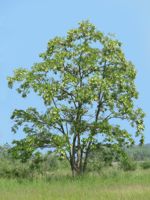Mon-Fri 9am - 5pm Mountain time
Black Locust vs Russian Mountain Ash
Robinia pseudoacacia
Sorbus aucuparia Rossica
NOT AVAILABLE THIS SEASON - MIGHT RETURN
Black Locust is an attractive tree. Its distinctive leaves are made of about a dozen bright green leaflets. It also notable for its fragrant white flowers, which smell of citrus.
Black Locust can grow in many situations, but prefers dry areas with lots of sun. It is robust and is an excellent choice for establishing shade in dry, open areas.
Important note: Much of the Black Locust is toxic to humans and livestock, including seeds, bark, and leaves.
The Russian Mountain Ash is a stunning ornamental tree with the perfect pop of colour. It bears white flowers in the spring and gorgeous orange berries in the fall. Birds enjoy the berries that persist into the winter. It grows tall and can thrive in an urban setting making this an attractive ornamental tree for your landscaping project.

